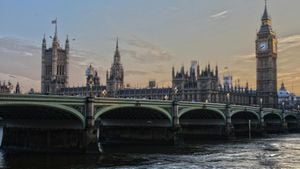New York City's congestion pricing initiative is gearing up to launch on January 5, 2025, and the conversation surrounding its potential impact on local businesses is heating up. Having just cleared all legislative hurdles, the new pricing system introduces a $9 toll for drivers entering Manhattan below 60th Street during peak hours if they utilize E-ZPass; non-E-ZPass users will pay $13.50. The intent behind this measure is to reduce traffic congestion and generate revenue for the city and its crumbling transit infrastructure. Yet, as City officials prepare for implementation, the voices of discontent grow louder, especially from neighboring New Jersey.
During a recent appearance on The Point with Marcia Kramer, New Jersey Senator George Helmy expressed his apprehension about the tolling plan, arguing it could significantly affect both New Jerseyans and Manhattan's business ecosystem. "I think, frankly, it's bad for New Jersey and it's bad for the city," Helmy stated, echoing the sentiments of those who believe congestion pricing could double-tax commuters already grappling with financial strains.
Gov. Phil Murphy of New Jersey and Rep. Josh Gottheimer have also voiced their dissent from the start, with Gottheimer pointing out the growing chorus of New York City-based organizations stating the pricing is detrimental to both business growth and the working-class populace. There’s fear among critics like Helmy, who suggest the toll may drive businesses across the Hudson River to New Jersey, drawing employees who currently work in Manhattan out of the city for good.
According to Helmy, many people commute to Manhattan daily from New Jersey, particularly those living north or along the shore. The senator highlighted, "If they can get our businesses to move to Jersey City or Hoboken, where we're already seeing some of this influx, I think it's going to be good for New Jersey. But, as I said, Marcia, I think it's bad for the city." This perspective raises questions about the toll's long-term effects: will businesses opt for the convenience of lower operating costs across the river, or will existing companies stay loyal to New York driving the commuter and customer traffic necessary for survival?
The essence of this debate lies within the broader discussion of transit equity. Helmy emphasizes the need for sustainable mass transit funding, remarking, "Mass transit in this nation is wholly underfunded, and we need to find ways to continue the investments as our population grows, our cities grow, and we need to get people out of cars and onto mass transit". It’s hard to ignore the challenges working families face amid rising costs of living, especially with gas prices and inflation pinching wallets tighter than ever. Is introducing more tolls during such challenging economic times truly the best solution?
Supporters of congestion pricing argue it could encourage more people to utilize public transportation, thereby easing traffic congestion and boosting sustainability efforts. The hope is to transform city traffic conditions, reducing vehicular gridlock during rush hours. This, paired with the revenue potential for funding city improvements and transit support, holds appeal to some city planners. There’s optimism around the idea of reinvesting this money to fix decaying subway systems and upgrade buses, making mass transit not just more appealing but more reliable.
Critics, on the other hand, want to know why the burden seems to fall heavily on commuters. They argue this plan doesn't address the biggest issues plaguing the public transit system, like increasing fares and declining service reliability. Instead of merely reining these commuter costs back through road charging, advocates for transit reform suggest the need for focused improvements such as expanded bus routes, increased subway frequency, and overall enhancements to public transport quality.
Some business owners within Manhattan's core express their concerns about losing out on foot traffic if their customers choose to evade congestion fees by shopping elsewhere. The heart of the matter is simple—the more burdens placed on consumers, the less likelihood they will enter the city. Retailers along major pathways fear their sales will decline as tolls make driving less enticing. Local shops and restaurants worry they may see dwindling patrons as the added expense discourages spontaneous dining and shopping outings.
For many organizations, the increase of operational costs isn’t only about drivers; it’s about everyone. Even delivery drivers, the lifeblood of businesses like restaurants, could face heightened costs to navigate through congested areas, potentially passing additional charges onto consumers. This domino effect of charges raises the contentions surrounding congestion pricing and its likely ramifications as more eyes critically observe its potential fallout.
But not all community voices lean against congestion pricing. Some see hope and potential benefits for societal growth amid environmental concerns. Green initiatives posit reduced emissions from fewer vehicles might improve air quality and promote healthier urban living spaces. Advocates note the system could theoretically reward those choosing to bike, walk, or use mass transit rather than drive. This could spark broader community efforts to promote eco-friendly behaviors, aligning with city-wide goals of sustainability amid the climate crisis. It’s less about generating more money and more about cultivating livability within the city without sacrificing economic viability.
The interplay between New York City and its surrounding areas continues to create rich discussions laden with varied perspectives, desires, crises, and aspirations. Unfortunately, like many initiatives aimed at tackling complex urban problems, something valuable is often sacrificed. It’s hard to know for certain if congestion pricing will drive businesses to ditch their New York bases for more favorable monetary opportunities across the river. This uncertainty leaves local officials needing to tread carefully as the mandatory charging date approaches.
Indeed, the question arises: how will local stakeholders manage this disruption and anticipate incoming changing business landscapes?” It seems the reality is rooted less within clean-cut solutions and more within communal adaptation.
To stay updated on this significant discussion, more dialogues will be needed, from the corners of council chambers to the diner tables of local neighborhoods, emphasizing the voices of both the businesses impacted and those celebrating the shifts to greater accountability within traffic and transportation systems.



